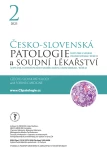Issues of electric shock in forensic medical practice
Authors:
Markéta Kulvajtová 1; Radoslav Matěj 2; Jiří Hladík 1
Authors place of work:
Ústav soudního lékařství 3. LF a Fakultní nemocnice Královské Vinohrady, Praha
1; Ústav patologie 3. LF UK a Fakultní nemocnice Královské Vinohrady, Praha a Ústav patologie a molekulární medicíny 3. LF UK, a Thomayerovy nemocnice, Praha
2
Published in the journal:
Soud Lék., 68, 2023, No. 2, p. 12-14
Category:
Přehledový článek
Summary
The authors summarize the current state of knowledge of electric shock as a minority group of injuries in forensic practice. Initially, they deal with electric current as a physical quantity and its effect on the human body, how it enters and moves in the body, which tissues due to their electrical activity and properties are the best conductors and which, on the contrary, due to their high resistance, practically do not conduct current. Subsequently, different pathways of current passage through the body are mentioned, leading to different types of damage, the most serious of which appears to be damage to the cardiovascular system, which can lead to immediate death due to disturbed heart rhythm with subsequent arrest, but is also likely to leave permanent effects leading to late health complications. The effect of electric current at the cellular level is demonstrated in experimental animal models exposed to both low- and high-voltage electric current, with damage described not only at the site of entry but also by microscopic examination in organs distant from the site of direct electric current. Since the effect of electric current on the organism is not fully understood and experimental studies have produced results indicating damage mainly to the cardiovascular system, this opens up certain possibilities for improving not only the diagnosis of deaths due to electric shock but also the follow-up care of patients who survive these injuries.
Keywords:
electrocution – effects on the body – diagnosis of damage
Zdroje
1. Rosina J, Navrátil L, Malay M, Sabo J. Biofyzika elektrických projevů a účinků elektrické energie, diagnostické a terapeutické metody využívající elektrické energie. In: Navrátil L, Rosina J a kolektiv. Medicínská biofyzika, Grada, 2019.
2. Rosina J, Vránová H, Kolářová H. Elektrický proud. In: Rosina J, Vránová H, Kolářová H. Biofyzika pro zdravotnické a biomedicínské obory, Grada, 2021.
3. Waldmann V, Narayanan K, Combes N, Jost D, Jouven X, Marijom E. Electrical cardiac injuries: current concepts and management. Eur Heart J 2018; 39: 1459-1465.
4. Fineschi V, Di Donato S, Mondillo S, Tirillazzi E. Electric shock: Cardiac effects relative to non fatal injuries and post mortem findings in fatal cases. Int J Cardiol 2006; 111: 6-11.
5. Bryan BC, Andrews ChJ, Hurley RA, Taber KH. Electrical Injury, Part1: Mechanisms. J Neuropsychiatry Clin Neurosci 2009; 21(3): 240-244.
6. Lee RC. Cell Injury by Electric Forces. Ann NY Acad Sci 2005; 1066: 85-91.
7. Tsong TY, Su Z-D. Biological effects of electric shock and heat denaturation and oxidation molecules, membranes and cellular functions. Occupational electrical injury: An international symposium 1999; 888(1): 211-232.
8. Wang Y, Liu M, Cheng W-B, Li F, Liao Z, Wang Y. Endothelial cell membrane perforation of aorta and pulmonary artery in the electrocution victims. Forensic Sci Int 2008; 178: 204-206.
9. Koren O, Paz E, Rozner E, Mahamid M, Turgeman Y. Late myocardial sequelae of eletrical injury. Clin Case Rep 2020; 8: 3407- 3410.
10. Carmeliet P, Moons L, Stassen J-M, De Mol M, Bouché A, Van der Oord JJ, Kockx M, Collen D. Animal Model: Vascular Wound Healing and Neointima Formation Induced by Perivascular Electric Injury in Mice. Am J Pathol 1997; 150 (2): 761-776.
11. Jia-ke Ch, Li-gen L, Quan-wen G, Xiao-peng S, Hai-jun Z, Zhi-yong S, Zhi-qiang W, Cai Z. Establishment of soft-tissue injury model of high-voltage electrical burn and observation of its pathological changes. Burns 2009; 35: 1158-1164.
12. Lanier ST, McClain SA, Lin F, Singer AJ, Clark RAF. Spatiotemporal progression of cell death in the zone of ischemia surrounding burns. Wound Repair Regen 2011; 19(5): 622-632.
13. James TN, Riddick LR, Emry JH. Cardiac abnormalities demonstrated postmortem in four cases of accidental electrocution and their potential significance relative to nonfatal electrical injuries of the heart. Am Heart J 1990; 120(1): 143-157.
14. Štefan J, Hladík J, Adámek T. Forenzní traumatologie. In: Štefan J, Hladík J a kolektiv. Soudní lékařství a jeho moderní trendy, Grada, 2012.
15. Patil RN, Tijare J, Raut W. Histopathological examination of skin in electrocution deaths: one year autopsy study. Indian J Forensic Community Med 2017; 4(4): 255-260.
16. Dolinak D, Matshes E, Lew E. Environmental Injury. In: Forensic Pathology Principles and Practise. Elsevier Academic Press, 2005.
17. Saukko P, Knight B. Knight´s Forensic Pathology. New York: Arnold-Oxford University Press Inc.; 2015: 326-337.
18. Řehulka H. Poranění elektrickým proudem. In: Hirt M. a kolektiv. Soudní lékařství I. díl, Grada, 2015.
19. Dettmeyer RB. Forensic Histopathology Fundamentals and Perspectives. Berlin, Heidelberg: Springer Verlag; 2011: 155-159.
Štítky
Patologie Soudní lékařství ToxikologieČlánek vyšel v časopise
Soudní lékařství

2023 Číslo 2
Nejčtenější v tomto čísle
- Problematika úrazů elektrickým proudem v soudně lékařské praxi. Úvodní, teoretická část
- Neplánovaná komplexná samovražda 6 mm Flobert revolverom a skokom pod vlak: kazuistika
- Alkohol a návykové látky u zemřelých aktivních účastníků dopravních nehod
- Volodymyr Shylov – vystoupení k aktuální problematice válečných zločinů na Ukrajině.
